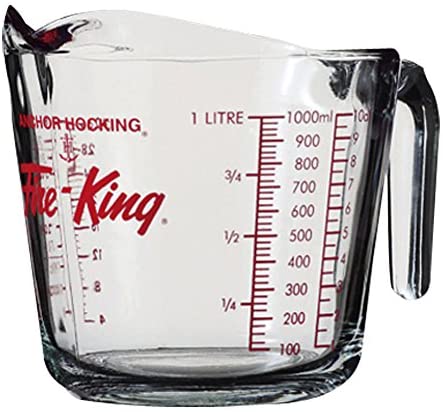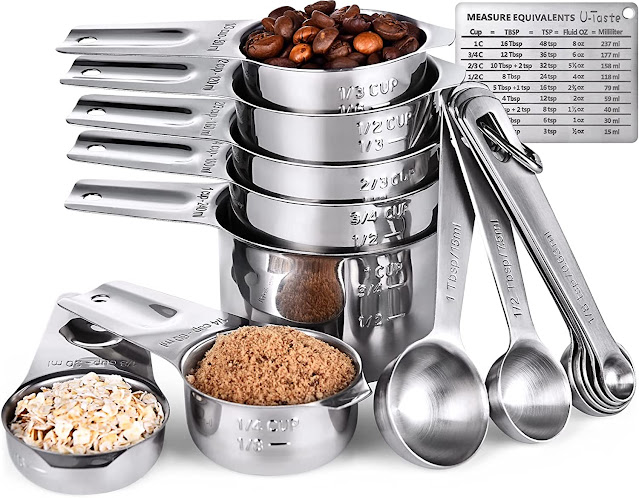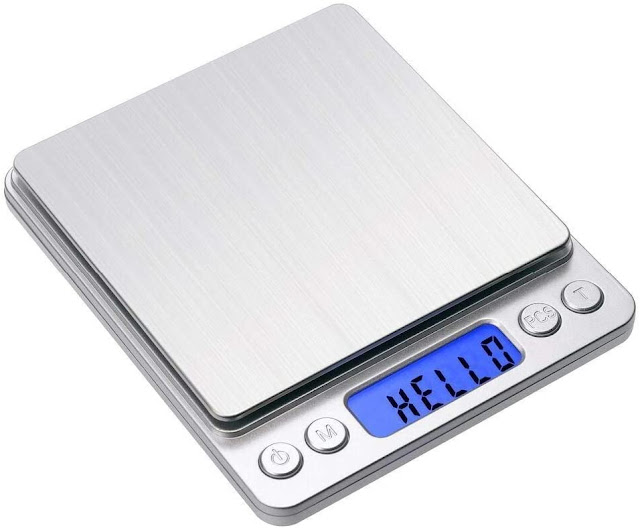Repeatable successful cooking and baking results require accurate measuring practices. Here are ten valuable tips on how to measure your recipe ingredients.
Were you lucky enough to
observe your grandma or mom bake and cook? Were you fascinated by watching them
use their trusted old measuring cup and pinch of this and dash of that to make
the most soul-pleasing comfort foods?
Years of experience led
them to have instincts on measuring that yielded successful results for their
cakes and sauces.
Thanks to modern
technology and kitchen utensils, we don't have to rely on just guesswork or
wait to inherit that trusted mug from grandma.
Here are ten useful tips
on measuring ingredients in the kitchen.
#1 Invest In High Quality Measuring Tools and Utensils
Thanks to some wonderful
kitchen appliance and utensil manufacturers, we don't have to rely on that
trusted mug from grandma to measure out the ingredients.
We recommend you invest
in high-quality measuring utensils, equipment, and tools.
#2 Use Measuring Cups
For Liquids
For liquids, we
recommend using a liquid measuring cup. They are usually made of plastic or
glass, and they have clear demarcation of ounces, cups, and milliliters. It
will also be helpful if the cup is microwave-safe. Often you may need to use
lukewarm milk or water, and it is best to measure out the cold liquid and zap
it in the microwave for a few seconds to make it lukewarm.
It will also be helpful
if the plastic or glass is clear to see through the material to gauge the level
you poured into it (more on it later). Use a cup that has a pouring spout and a
handle.
#3 Use Measuring Cups
Made For Larger Volumes of Dry Ingredients
We recommend you use a series of metal or plastic measuring cups
with handles for larger volumes of dry ingredients. They usually come in sets
of 4 cups with 1 cup, ½ cup, ¼ cup, and ⅛ cup measurements. We recommend you
buy the same series of cups to be consistent with your measurement.
These cups are great for
measuring flour, grain, rice, pulses, baking powder, etc.
You can also use these
to measure out liquids like oils and molasses or honey. However, we still
recommend you have a measuring cup for the liquid separate from dry
ingredients.
This will make life
easier when measuring the liquid and dry ingredients for the same recipe.
#3 Use Measuring Spoons
Made For Smaller Volumes of Dry Ingredients
Measuring spoons have
more accurate measurements than tablespoons from silverware or tableware. You
can use measuring spoons for smaller volumes of dry ingredients instead of using tablespoons
from your silverware. Different manufacturers of knives, spoons, and forks can
tinker with the exact measurement of the spoons for design and aesthetics.
So, instead, pick a set of measuring spoons. They usually come
in a set of several spoons from 1 tablespoon, ½ tablespoon, ⅓ tablespoon, ¼
tablespoon, ⅛ tablespoon, and also in 1 teaspoon, ½ teaspoon, ¼ teaspoon, and ⅓
teaspoon measurements.
Again picking all the
measuring spoons from the same set by the same manufacturer will increase your
chance of accuracy in your recipe
measurements.
#4 Use a Food Measuring
Scale
Professional cooks and
chefs will always use a food measuring scale to measure out exact volumes of
ingredients. This is because depending on the humidity and how tightly the
powdered ingredients are packed, simply using measuring cups may not be as
accurate as precisely measuring the volume of the powdered ingredient (like
flour or sugar, etc.).
We recommend you use the
measuring utensils and then weigh them on a food scale to ensure you correctly
measure ingredients. This will ensure your chocolate cake is perfect
every time.
#5 Pick Either to
Scoop-and-Level Or Spoon-and-Level Methods
There is an ongoing
debate in the avid baking communities about how exactly to put ingredients in a
measuring cup - yes, they can be that fussy about precision when creating
delicate desserts and baked goods.
One school of thought
uses the measuring cup to scoop out the ingredient and then level it off with a
knife to get a cup of powdered or granulated dry ingredient - like flour or
sugar.
The other theory is to
use a spoon to fill the measuring cup and then level it off with a knife.
What is the difference,
you wonder?
Well, the difference is
in science. When you scoop up the ingredient with a cup, you can scoop more
flour than if you were filling the cup with a tablespoon of flour at a time. It
is because of the air trapped between each spec or grain of the ingredient.
Neither methods are
right or wrong, as long as you are consistent with your technique.
Our recommendation is to
pick one method and stick to it. If you are going to scoop and level, then do
that with all the ingredients. If you are going to spoon and level, stick to
that technique.
You can always measure
out the ingredient on a food scale after scooping or spooning it into your
measuring cup for extra accuracy.
#6 Use a Little Oil for
Sticky Ingredients
When measuring sticky
ingredients like honey, molasses, peanut butter, or maple syrup, we recommend
spraying or brushing a little cooking oil on the measuring cup before pouring
the sticky stuff into it. This will ensure that you can pour the sticky
ingredient into the mixing bowl with little wastage.
Because accuracy is
vital in baking, you will not want to waste even a single drop of the sticky
ingredient. Using a bit of oil will ensure the sticky ingredient doesn't stick
to the surface of the measuring utensil, and you get all of it in your mixing
bowl.
#7 Use Silicone
Spatulas to Transfer Ingredients
We recommend getting a
set of silicone spatulas of different sizes to scoop out the wet and sticky wet
ingredients from the measuring cups. You will need to use these spatulas to
cleanly take out the wet and sticky ingredients into the mixing bowl.
The same goes for the
cake batter you will mix in your bowl.
We recommend you get a
set of spatulas of different sizes. We suggest sticking to silicone because of
the bendy malleability that makes it super helpful in scooping out the tiniest
bit of batter or ingredients from all corners of your cups and bowls.
#8 Line Up All
Ingredients
You will need to work
with several ingredients when creating a cake recipe. This can get confusing,
which may lead you to forget if you added the baking soda or are you yet to add
it, for example.
So, we recommend you
line up all the ingredients on the counter before you start measuring and
mixing. This includes the salt for the pinch of salt or the tiniest dash of
nutmeg.
Line them up as they do
in cooking videos online. Set the ingredients all on one side of the mixing
bowl - e.g., the left side. As you add the ingredient, place the ingredient
jar/box on the other side of the bowl - e.g., the right side.
#9 Measure and Pour
Away from the Mixing Bowl
Just Like how every
online cooking video will tell you to crack the egg away from the bowl into a
separate bowl before adding it to the cake batter, you should do the same with
other ingredients.
Whether you scoop and
level or spoon and level, there is a chance you may spill some extra out of the
cup. So, if you are doing this over your mixing bowl, the extra dash of flour
or sugar will fall right into the mixing bowl screwing up the accuracy level of
the recipe measurement.
#10 Pay Attention to
the Recipe
Finally, pay close
attention to all the recipe instructions. If the recipe calls for sifted flour,
you will need to measure the flour out, sift it, and then measure it again to
ensure the measurement is accurate.
For liquids, bend down
or lift the cup to ensure the markers are at your eye level so that the volume
is accurate.
Conclusion
Cooking is an art, while
baking is a science. We like to think both of them are a blend of art and
science. Yes, you can experiment with ingredients and add spice or herb to your
recipe to make it your own. However, you still have to get measurements of the
bulk of the ingredients to ensure the result tastes how it's supposed to.
After all, the play of
moisture, vapor, heat, and ingredients melding together will produce your next
most delectable dish. Good luck!













I'm so excited that most of these I already do! Good idea about the sticky spoon, though!
ReplyDelete